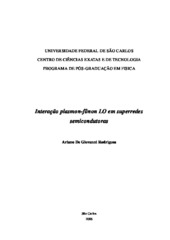| dc.contributor.author | Rodrigues, Ariano de Giovanni | |
| dc.date.accessioned | 2016-06-02T20:15:19Z | |
| dc.date.available | 2009-06-30 | |
| dc.date.available | 2016-06-02T20:15:19Z | |
| dc.date.issued | 2008-10-07 | |
| dc.identifier.citation | RODRIGUES, Ariano de Giovanni. Interação plasmon-fônon LO em superredes semicondutoras. 2008. 72 f. Tese (Doutorado em Ciências Exatas e da Terra) - Universidade Federal de São Carlos, São Carlos, 2008. | por |
| dc.identifier.uri | https://repositorio.ufscar.br/handle/ufscar/4911 | |
| dc.description.abstract | This work presents a Raman investigation of the optical vibrations in highly doped In-GaAs/InP and GaAs/AlGaAs superlattices (SL s). The InGaAs/InP SL s grown with different
periods were analyzed using polarized Raman techniques. No Raman selection rules were found in the long period InGaAs/InP SL s due to the structural defects in the bulk materials constituting the layers. With the decrease of the SL period the selection rules emerges and considerable blue shift of the longitudinal optical mode originated in the barriers were observed, as a manifestation of the coupled plasmon-LO phonon vibrations propagating along the growth axis. The
observed effect can be attributed to the formation of the miniband electron energy structure. A quantitative analysis showed that the selection rules noticed in the longitudinal optical vibrations of the short period SL s occur due to the increasing of the coherence length of the coupled modes with respect to the coherence length of the optical phonon. The GaAs/AlGaAs SL s studied were growth with different disorder strengths. In weakly disordered SL s we also observed the coupling between the vertical plasmon and the longitudinal optical phonons of the barriers. The lineshape analysis of the sprectra measured in the strongly disordered SL s allowed us to obtain the plasmon damping constant, proving that in these samples the plasmon presents an overdamping behavior, that provokes the decoupling between the plasmon and the LO-phonon. For the first time we have shown aphysical system in which we can control the plasmon-LO
phonon interaction, changing from a coupled regime to a decoupled one, by varying the disorder strength. Plotting both the coherence lengths of the AlAs-like coupled modes and the
plasmon damping constants versus the disorder strengths we could draw some conclusion about the process of the transition from the coupled to uncoupled phase and to obtain the behavior of the plasmon relaxation as a function of the disorder. | eng |
| dc.description.sponsorship | Universidade Federal de Sao Carlos | |
| dc.format | application/pdf | por |
| dc.language | por | por |
| dc.publisher | Universidade Federal de São Carlos | por |
| dc.rights | Acesso Aberto | por |
| dc.subject | Raman, Espectroscopia de | por |
| dc.subject | Super redes | por |
| dc.subject | Interação plasmon-fônon | por |
| dc.subject | Minibanda | por |
| dc.title | Interação plasmon-fônon LO em superredes semicondutoras | por |
| dc.type | Tese | por |
| dc.contributor.advisor1 | Galzerani, José Cláudio | |
| dc.contributor.advisor1Lattes | http://buscatextual.cnpq.br/buscatextual/visualizacv.do?id=K4783800D6 | por |
| dc.description.resumo | Este trabalho apresenta um estudo das vibrações ópticas em superredes InGaAs/InP e em superredes GaAs/AlGaAs. As superredes InGaAs/InP crescidas com diferentes períodos foram analisadas através da obtenção de espectros Raman polarizados. Em virtude dos defeitos estruturais das camadas constituintes das superredes as regras de seleção Raman esperadas não foram observadas. À medida que o período das superredes diminui, além do modo longitudinal óptico (LO) originado nas barreiras apresentar um considerável deslocamento para maiores valores de energia, as regras de seleção Raman previstas para esse modo vibracional passam
a ser respeitadas. Esses efeitos dão indícios da presença do modo acoplado plasmon-fônon LO, que pode ser atribuído à formação de uma estrutura de minibanda no espectro de energia dos elétrons. Análises quantitativas mostraram que o aparecimento das regras de seleção nas superredes de períodos menores deve-se ao aumento significativo do comprimento de correlação dos modos acoplados em comparação com o do fônon longitudinal óptico. As superredes
GaAs/AlGaAs estudadas foram crescidas com diferentes níveis de desordem. As superredes com menores parâmetros de desordem também apresentam acoplamento entre plasmon vertical e o fônon LO das barreiras. As análises das formas das linhas dos espectros das superredes com maiores parâmetros de desordem permitiram-nos obter a constante de amortecimento do plasmon, provando que, neste caso, o plasmon apresenta um comportamento superamortecido que acarreta o desacoplamento entre o plasmon e fônon LO. Este trabalho mostra, pela primeira vez, um sistema no qual pode-se controlar o processo de interação plasmon-fônon LO, mudando do regime acoplado para o desacoplado, através da variação do nível de desordem. Graficando o comprimento de correlação do modo acoplado tipo AlAs e as constantes de amortecimento de plasmon em função do parâmetro de desordem, pudemos traçar algumas conclusões a respeito
da transição entre as fases acoplada e desacoplada e também obter o comportamento da relaxação do plasmon em função da desordem. | por |
| dc.publisher.country | BR | por |
| dc.publisher.initials | UFSCar | por |
| dc.publisher.program | Programa de Pós-Graduação em Física - PPGF | por |
| dc.subject.cnpq | CIENCIAS EXATAS E DA TERRA::FISICA | por |
| dc.contributor.authorlattes | http://genos.cnpq.br:12010/dwlattes/owa/prc_imp_cv_int?f_cod=K4730641T8 | por |
